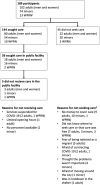Access to Health Care for Migrants Along the Mexico-United States Border: Applying a Framework to Assess Barriers to Care in Mexico
- PMID: 35910916
- PMCID: PMC9330619
- DOI: 10.3389/fpubh.2022.921417
Access to Health Care for Migrants Along the Mexico-United States Border: Applying a Framework to Assess Barriers to Care in Mexico
Abstract
Background: Migrants in Mexico are entitled to care at all levels, independently of their migration status. However, previous studies show that access to care is difficult for this population. As the movement of in-transit migrants and asylum seekers has been interrupted at the Mexico-United States border by migration policies such as the "Remain in Mexico" program, and by border closures due to the COVID-19 pandemic, the Mexican health system has the challenge of providing them with health care. Levesque et al.'s framework, according to which access occurs at the interface of health system characteristics and potential users' abilities to interact with it, is a useful theoretical tool to analyze the barriers faced by migrants.
Objective: The objective of this article is to analyze the barriers to access the public Mexican health system, encountered by migrants in cities in Mexican states at the Mexico-United States border during the COVID-19 pandemic.
Methods: Data came from a multiple case study of the response of migrant shelters to health care needs during the COVID-19 pandemic. The study consisted of a non-probability survey of migrants with a recent health need, and interviews with persons working in civil society organizations providing services to migrants, governmental actors involved in the response to migration, and academics with expertise in the subject. We analyzed the quantitative and qualitative results according to Levesque et al.'s framework.
Results: 36/189 migrants surveyed had sought health care in a public service. The main limitations to access were in the availability and accommodation dimension (administrative barriers decreasing migrants' ability to reach the system), and the affordability dimension (out-of-pocket costs limiting migrants' ability to pay). Civil society organizations were a major source of social support, helping migrants overcome some of the barriers identified.
Conclusions: While Mexico's health regulations are inclusive of migrants, in practice there are major barriers to access public health services, which might inhibit migrants from seeking those services. In order to comply with its commitment to guarantee the right to health of all persons, the Mexican health authorities should address the implementation gap between an inclusive policy, and the barriers to access that still remain.
Keywords: Mexico; accessibility; health services access; health systems; implementation gap; migrants.
Copyright © 2022 Infante, Vieitez-Martinez, Rodríguez-Chávez, Nápoles, Larrea-Schiavon and Bojorquez.
Conflict of interest statement
The authors declare that the research was conducted in the absence of any commercial or financial relationships that could be construed as a potential conflict of interest.
Figures


Similar articles
-
In-Transit Migrants And Asylum Seekers: Inclusion Gaps In Mexico's COVID-19 Health Policy Response.Health Aff (Millwood). 2021 Jul;40(7):1154-1161. doi: 10.1377/hlthaff.2021.00085. Health Aff (Millwood). 2021. PMID: 34228514 Review.
-
"We want our freedom back, that's our only need": a qualitative study of health and social needs among asylum seekers and undocumented migrants crossing the borders from Belarus to Lithuania.Front Public Health. 2024 May 2;12:1371119. doi: 10.3389/fpubh.2024.1371119. eCollection 2024. Front Public Health. 2024. PMID: 38756883 Free PMC article.
-
Health and well-being of refugees, asylum seekers, undocumented migrants, and internally displaced persons under COVID-19: a scoping review.Front Public Health. 2023 Apr 26;11:1145002. doi: 10.3389/fpubh.2023.1145002. eCollection 2023. Front Public Health. 2023. PMID: 37181725 Free PMC article.
-
The epidemiological follow-up process for suspected and confirmed cases of COVID-19 in migrant shelters on the northern border of Mexico from July to December 2020: Between contagion underestimation and containment.Front Public Health. 2023 Jan 12;10:980808. doi: 10.3389/fpubh.2022.980808. eCollection 2022. Front Public Health. 2023. PMID: 36711368 Free PMC article.
-
Health Profile and Health Care Access of Mexican Migration Flows Traversing the Northern Border of Mexico.Med Care. 2020 May;58(5):474-482. doi: 10.1097/MLR.0000000000001300. Med Care. 2020. PMID: 32028523 Free PMC article.
Cited by
-
Asylum seekers and the role of the acute care physician.J Am Coll Emerg Physicians Open. 2024 Jun 16;5(3):e13196. doi: 10.1002/emp2.13196. eCollection 2024 Jun. J Am Coll Emerg Physicians Open. 2024. PMID: 38887226 Free PMC article. Review.
-
"When you leave your country, this is what you're in for": experiences of structural, legal, and gender-based violence among asylum-seeking women at the Mexico-U.S. border.BMC Public Health. 2023 Sep 2;23(1):1699. doi: 10.1186/s12889-023-16538-2. BMC Public Health. 2023. PMID: 37659997 Free PMC article.
-
Migrant Men Living in Brazil during the Pandemic: A Qualitative Study.Int J Environ Res Public Health. 2024 Jan 18;21(1):109. doi: 10.3390/ijerph21010109. Int J Environ Res Public Health. 2024. PMID: 38248571 Free PMC article.
-
Sexual and reproductive health of in-transit migrant women en route to the United States: a mixed-methods study in Ciudad Juárez, Mexico.BMC Glob Public Health. 2025 Jul 7;3(1):60. doi: 10.1186/s44263-025-00180-8. BMC Glob Public Health. 2025. PMID: 40624714 Free PMC article.
-
Why Emergency Physicians Should Advocate for Suspension of Title 42 Restrictions on Asylum for US Immigrants.West J Emerg Med. 2023 Feb 22;24(2):149-151. doi: 10.5811/westjem.2022.11.59464. West J Emerg Med. 2023. PMID: 36976601 Free PMC article. No abstract available.
References
Publication types
MeSH terms
LinkOut - more resources
Full Text Sources
Medical
Research Materials
Miscellaneous

